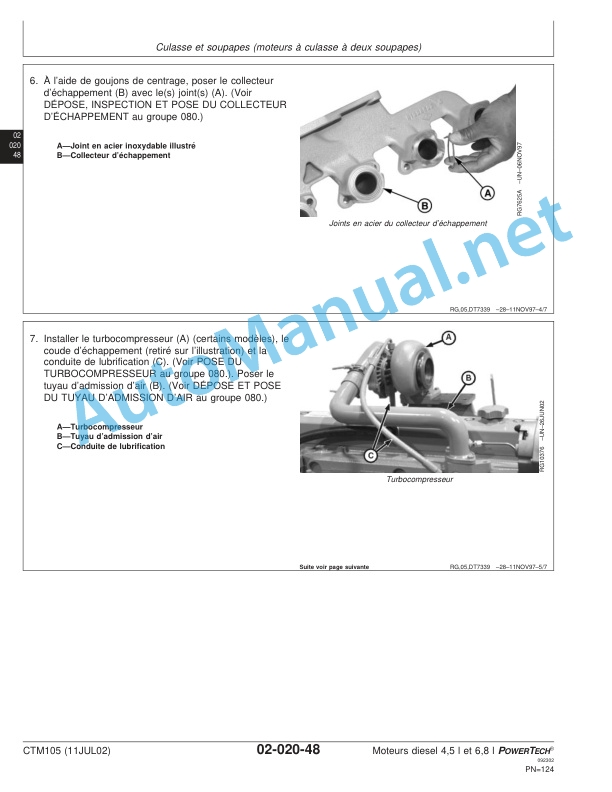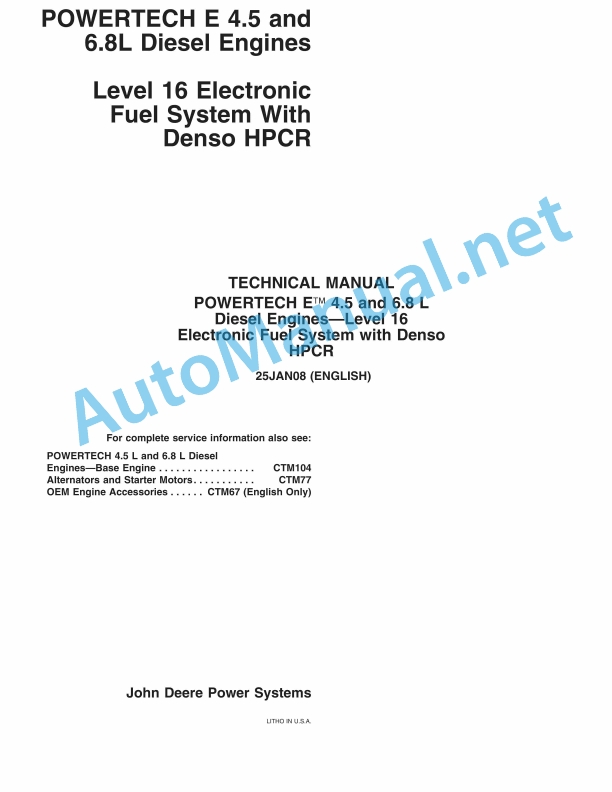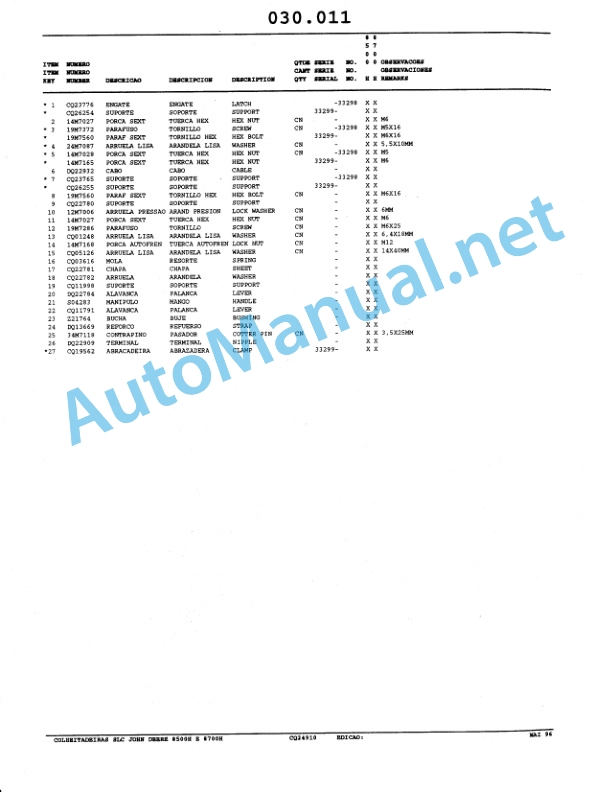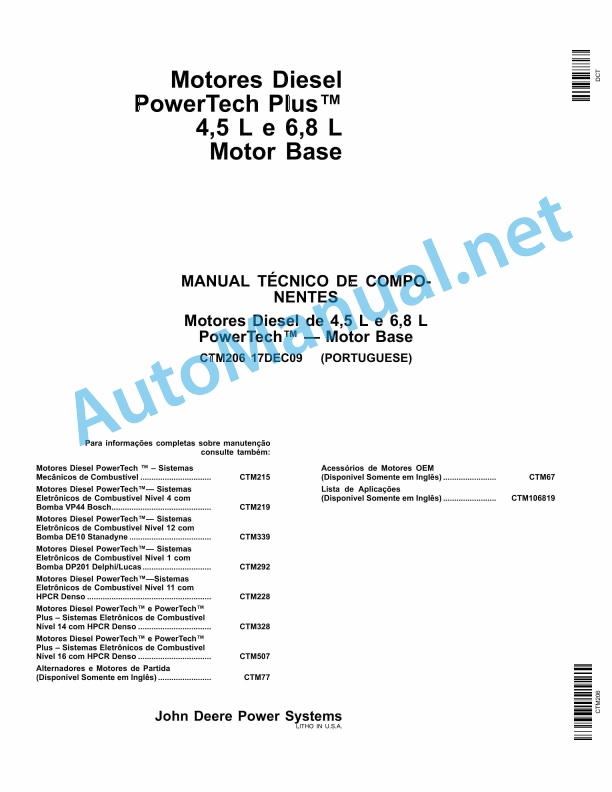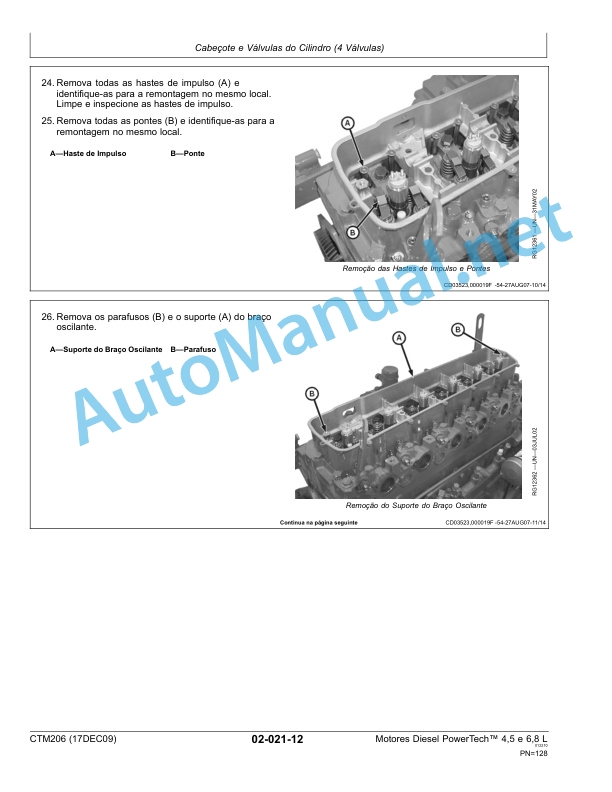Claas Torion 639 (K52) Wheel Loaders Operator Manual ES
$50.00
- Model: Torion 639 (K52) Wheel Loaders
- Type Of Manual: Operator Manual
- Language: ES
- Format: PDF(s)
- Size: 50.3 MB
File List:
00 0302 379 2.pdf
00 0303 256 0.pdf
00 0302 379 2.pdf:
TORION 639TORION 535
1. Introduction
1.1 General information
1.1.1 Validity of the manual
1.1.2 Information relating to this instruction manual
1.1.3 Symbols and indications
1.1.4 Optional equipment
1.1.5 Qualified specialized workshop
1.1.6 Maintenance instructions
1.1.7 Information regarding warranty
1.1.8 Spare parts and technical questions
1.2 Proper application of the machine
1.2.1 Proper machine application
1.2.2 Logically foreseeable misuse
2 Security
2.1 Recognize warning signs
2.1.1 Danger symbols
2.1.2 Keyword
2.2 Safety instructions
2.2.1 Meaning of the instruction manual
2.2.2 Observe graphic danger symbols and alarm indications
2.2.3 Requirements for all people working with the machine
2.2.4 Children in danger
2.2.5 Danger zones
2.2.6 Accompanying persons
2.2.7 Coupling the machine with a trailer
2.2.8 Construction changes
2.2.9 Optional equipment and spare parts
2.2.10 Protection against overturning and gravel impacts
2.2.11 Control of the machine in operation
2.2.12 Operation only after correct commissioning
2.2.13 Technical status
2.2.14 Danger due to machine breakdowns
2.2.15 Comply with technical limit values
2.2.16 Keep protective devices operational
2.2.17 Personal protective equipment
2.2.18 Wear appropriate clothing
2.2.19 Remove dirt and loose objects
2.2.20 Field of vision and vision aids
2.2.21 Prepare the machine for road traffic
2.2.22 Dangers when driving on the road and in the countryside
2.2.23 Park the machine safely
2.2.24 Unsuitable consumables
2.2.25 Safe handling of consumables and auxiliary materials
2.2.26 Fuel is harmful to health
2.2.27 Cooling agents are harmful to health
2.2.28 Environmental protection and waste disposal
2.2.29 Keep the cabin free of chemical materials
2.2.30 Fire hazard
2.2.31 Deadly current discharge due to overhead power lines
2.2.32 Behavior in the case of voltage discharge through unprotected cables and lightning strikes
2.2.33 Electrical shock from electrical equipment
2.2.34 Vibrations can cause health injuries
2.2.35 Liquids under pressure
2.2.36 Toxic exhaust gases
2.2.37 Hot surfaces
2.2.38 Getting on and off safely
2.2.39 Work only on the stopped machine
2.2.40 Maintenance work and repair work
2.2.41 Lifted loads
2.2.42 Danger from welding work
2.2.43 Check and charge the battery
2.3 Safety signage
2.3.1 Structure of graphic hazard symbols
2.3.2 Graphic danger symbols on the machine
Graphic danger symbol
Graphic danger symbol
Graphic danger symbol
Graphic hazard symbol
Graphic hazard symbol
Graphic danger symbol
Graphic danger symbol
Graphic danger symbol
Graphic danger symbol
3 Machine Description
3.1 Summary and operation
3.1.1 Wheel Loader Overview
3.1.2 Overview of work lighting and driving lights
3.2 Optional equipment
3.2.1 Coolant preheating
3.2.2 Mounting plate
3.2.3 Crane arm
3.3 Identification plates and identification numbers
3.3.1 Nameplate position
3.3.2 Information on the identification plate
3.4 Machine information
3.4.1 Position of the stickers
3.4.2 Adhesives
Working hydraulic system
Acoustic power level
Brake fluid
Window washer fluid
Cooling equipment
Cooling agent*
Stop point, lifting point
tie point
Parking break
Extinguisher
Greasing scheme
Emergency exit
Check the fixation of the wheels
ROPS/FOPS
Load capacity chart for pallet fork operation*
Diesel oil
Load capacity table for spreader device*
4 Control and display instruments
4.1 Cabin and driving position
4.1.1 Driver’s platform
4.1.2 Keyboard
4.1.3 Multifunctional control
4.1.4 Ignition contact
4.1.5 Steering control bar
4.1.6 Hand-Inch*
4.2 On-board information system
4.2.1 Warning messages and fault messages
4.2.2 Screen
4.2.3 Summary of symbols
5 Technical data
5.1 TORION
5.1.1 Measurements with ladle
5.1.2 Measurements with 4 in 1 bucket*
5.1.3 Measurements with pallet fork*
5.1.4 Measurements with ladle
5.1.5 Measurements with 4 in 1 bucket*
5.1.6 Measurements with pallet fork*
5.1.7 Vibrations
Vibrations in the hand and arm
Whole body vibrations
5.1.8 Sound pressure level and sound power level
5.1.9 Use temperature
5.1.10 4TNV98C diesel engine
5.1.11 Chassis
Propulsion
walking speed
5.1.12 Axes
front axle
Rear axle
5.1.13 Tires and tire pressure
5.1.14 Tires and tire pressure
5.1.15 Snow chains* or tire protection chains*
5.1.16 Foam filling in tires*
5.1.17 Brake
5.1.18 Address
5.1.19 Elevation chart
Duty cycle time with payload
Duty cycle time with payload
5.1.20 Load capacity table for telescopic crane arm
5.1.21 Towing hitch
5.1.22 Mounting plate*
5.1.23 Hydraulic installation
5.1.24 Electrical installation
5.1.25 Cabin
Driver’s seat
Heating, ventilation
Air conditioning equipment
5.2 Inputs
5.2.1 Lubricants
5.2.2 Hydraulic oil
5.2.3 Coolant liquid
5.2.4 Fuels
5.2.5 Cooling agent
6 Preparation of the machine
6.1 Turn off the machine and secure it
6.1.1 Turn off the machine and secure it
6.1.2 Lowering work equipment onto the ground
6.1.3 Connecting and disconnecting the battery separator switch
6.1.4 Secure the machine so that it cannot roll
Leave the machine with the diesel engine off
Leave the machine with the diesel engine on
6.2 Access jobs and maintenance positions
6.2.1 Accessing the workplace in the cabin
Access the cabin
Leave the cabin
6.3 Diesel engine
6.3.1 Take into account the fuel specification
6.3.2 Select an allowed fuel
6.3.3 Use winter fuel at low temperatures
6.3.4 Refuel
6.4 Elevation chart
6.4.1 Dismantle work equipment
6.4.2 Download the hydraulic pressures of the work equipment
6.4.3 Separate hydraulic pipes
6.4.4 Unlock and uncouple the work equipment
Operation with additional joystick
Operation with switch and key
6.4.5 Assemble work equipment
6.4.6 Coupling and blocking of work equipment
Operation with additional joystick
Operation with switch and key
6.4.7 Connect the hydraulic pipes
6.4.8 Carry out a check on the jamming of work equipment
Visual control
Mechanical control
6.4.9 Calibrate work equipment
6.5 Load the machine
6.5.1 Prepare the machine for loading
6.5.2 Load the machine
6.5.3 Driving the machine to a loading surface
6.5.4 Removing the machine from a loading surface
6.5.5 Tying the machine
6.5.6 Joint lock
Application of joint lock
Release of joint lock
6.6 Assembled parts and machine casing
6.6.1 Assembling and disassembling the mounting plate*
Remove mounting plate
Assemble the mounting plate
7 Management
7.1 Driving and transportation
7.1.1 Prepare for driving
7.1.2 Prepare for road traffic
7.1.3 Driving
Start the machine
7.1.4 Pick up material
7.1.5 Transport and handle material
7.1.6 Transporting cargo on a slope
7.1.7 Driving on slopes
7.1.8 Empty work equipment
7.1.9 Change of location with high dump buckets
7.1.10 Load transfer with bucket with stepper
7.1.11 Flatten
Flatten forward
Flatten reverse
7.1.12 Dismantle material
Remove material from the slope
Remove wall material
7.1.13 Loading a transport vehicle
Transportation tours
Loading process
7.1.14 Loading large pieces of rock
7.1.15 Backing up the machine
7.1.16 Excavate material
Dig foundations
7.1.17 Towing the machine from the danger zone
Trailer with diesel engine running
Towing with the diesel engine off
7.1.18 Putting the propulsion in free circulation
7.2 Diesel engine
7.2.1 Preheat the diesel engine coolant*
7.2.2 Connect the diesel engine
Heating norm
7.2.3 Turn off the diesel engine
7.2.4 Automatic diesel engine shutdown*
7.3 Chassis
7.3.1 Shift into gear
7.3.2 Select the direction of travel
7.3.3 Switching vibration damping on and off*
7.3.4 Operating the Hand-Inch device*
7.4 Brake
7.4.1 Brake the machine
7.4.2 Engaging and disengaging the parking brake
7.5 Lifting table
7.5.1 Lock and release the working hydraulic system
7.5.2 Move the lifting box and work equipment
Raise the lifting box
Lifting frame lowering
Load the bucket
Download the bucket
Raise the lifting frame and, at the same time, load the bucket
Raise the lifting frame and, at the same time, unload the bucket
Lower the lifting frame and, at the same time, load the bucket
Lower the lifting frame and, at the same time, unload the bucket
7.5.3 Work equipment with additional hydraulic functions*
7.5.4 Switching floating position on and off
7.5.5 Handle the pallet fork*
Adjusting the fork carriage tines
Working with the pallet fork
7.5.6 Operate the crane arm*
Assemble the crane arm
Adjust the crane arm
Working with the crane arm
7.5.7 Emergency operation of the lifting frame
7.5.8 Release the hydraulic pressure of the lifting box
7.6 Towing device
7.6.1 Operating the automatic trailer hitch*
hitch a trailer
Uncouple the trailer
7.7 Electrical and electronic system
7.7.1 Activate the parking position
7.7.2 Turn the lighting on and off
Turn the low beam on and off
Turn the high beam on and off
Turn work lights on and off
Connect the road traffic indicator
Turning the rotating flashing light on and off*
7.7.3 Additional control lever*
Additional control lever without control lever fixation
Additional control lever with control lever fixation
7.7.4 Comfort operation* and push-button operation*
Comfort operation
Push-button operation*
Connecting and disconnecting the additional function of the work equipment
Connect and disconnect continuous operation* of work equipment
7.7.5 Connecting and disconnecting reversing devices*
Reversing horn
Strobe light
Rotating flashing light at the rear
Rotating flashing light on cab roof
7.7.6 Electronic feed lock*
Deactivate the electronic feed lock
Activate the electronic feed lock
Program the ignition key
Delete ignition key
7.8 Cabin and driving position
7.8.1 Adjusting the driver’s seat
Adjust the driver’s pneumatic seat*
Adjust the seat suspension
Adjust seat height
armrest adjustment
Adjust lumbar support
Adjust backrest inclination
Adjust seat inclination
Adjust the seat horizontally
Adjust the driver’s seat horizontally
Switching horizontal damping on and off
Turn the seat heating on and off*
Adjust mechanically cushioned operator seat*
Adjust the seat suspension
Adjust seat height
armrest adjustment
Adjust lumbar support
Adjust backrest inclination
Adjust the driver’s seat horizontally
7.8.2 Putting on the seat belt
7.8.3 Adjust the steering column
7.8.4 Adjusting the interior mirror and exterior mirrors
7.8.5 Adjust heating, ventilation and air conditioning installation*
Adjust the temperature
Adjust the fan
Connect and disconnect the air conditioning installation*
Dry the cabin windows with REHEAT
7.8.6 Turning the cabin interior lighting on and off
7.8.7 Adjust the sunshade
7.8.8 Open and close the cabin windows
Open the right cabin window a crack
Open the right cabin window as far as the pneumatic shock absorber stops
Open the right cabin window 180°
Open the emergency exit
7.8.9 Switching the rear windshield heating on and off
7.8.10 Activate the window washer unit
Activate the front window washer unit
Activate the rear window washer unit
7.9 Centralized lubrication
7.9.1 Central lubrication system*
8 Incident and solution
8.1 Diesel engine
8.1.1 Summary of diesel engine error codes
8.1.2 Summary of diesel engine caution symbols
8.1.3 Summary of diesel engine faults
8.2 Brake
8.2.1 Summary of incidents in brake equipment
8.3 Address
8.3.1 Summary of incidents in the management team
8.4 Electrical and electronic system
8.4.1 12 V starting aid
Charge batteries
8.4.2 Summary of error codes
8.4.3 Summary of incidents in the electrical installation
8.4.4 Summary o tarter interlock faults
8.4.5 Base central electrical system
8.4.6 Main vehicle fuses
8.5 Hydraulic installation
8.5.1 Summary of faults in the propulsion hydraulic system
8.5.2 Summary of breakdowns in the working hydraulic system
8.6 Cabin and driving position
8.6.1 Summary of heating incidents
8.7 Centralized lubrication
8.7.1 Summary of faults in the central lubrication system
9 Maintenance
9.1 Maintenance intervals
9.1.1 Every 10 hours of service or daily
9.1.2 Every 50 hours of service
9.1.3 After the first 500 hours of service
9.1.4 Every 500 hours of service
9.1.5 Every 1000 hours of service
9.1.6 Every 2000 hours of service
9.1.7 Every 2 years
9.1.8 Every 3000 hours of service
9.1.9 Every 4000 hours of service
9.1.10 Every 6000 hours of service
9.1.11 Every 8000 hours of service
9.2 Greasing scheme
9.2.1 Grease the lubrication points every 10 hours of service
9.2.2 Grease the lubrication points every 50 hours of service
9.2.3 Grease the lubrication points every 500 hours of service
9.3 Prepare maintenance
9.3.1 Place the machine in maintenance position
Maintenance position I
Maintenance position II
9.3.2 Open the engine hood
9.4 Diesel engine
9.4.1 Clean the diesel engine
9.4.2 Check the diesel engine oil level
9.4.3 Drain condensation water from the fuel tank
9.4.4 Drain condensation water from the fuel prefilter
9.4.5 Change the fuel prefilter element
9.4.6 Change the fuel filter
9.4.7 Check the coolant level
9.4.8 Check the antifreeze protection of the coolant
Use of ready-mixed coolant
Use of anti-corrosion agents and concentrated antifreeze
9.4.9 Clean the refrigerant equipment
9.4.10 Clean the air filter
9.4.11 Clean the air filter element
9.4.12 Change the air filter safety cartridge
9.4.13 Diesel particulate filter regeneration
Adjust regeneration mode
Automatically start regeneration
Prevent regeneration
Manually start regeneration
9.5 Chassis
9.5.1 Check wheels, tires and tire pressure
9.5.2 Check tire air pressure
9.5.3 Check the tightening torque of the wheel nuts
9.6 Brake
9.6.1 Check the operation and effect of the service brake
9.6.2 Check the operation and effect of the parking brake
9.6.3 Check the brake fluid level of the service brake
9.7 Address
9.7.1 Check steering function
9.8 Elevation chart
9.8.1 Check the lifting frame bucket bushings
9.8.2 Check the operation of the tool holder
9.9 Hydraulic installation
9.9.1 Check the hydraulic oil level
9.9.2 Check the hydraulic hoses
9.10 Electrical and electronic system
9.10.1 Control lighting
9.11 Cabin and driving position
9.11.1 Clean or change the cabin fresh air filter
9.11.2 Check the condition and operation of the seat belt
9.11.3 Check the fill level of the window washer tank
9.11.4 Empty the condensation water from the air conditioning unit
9.12 Centralized lubrication
9.12.1 Fill the central lubrication system lubricant tank*
9.12.2 Check the tightness and operation of the central lubrication system*
9.13 Assembled parts and machine casing
9.13.1 Check the fire extinguisher
9.13.2 Free the machine from loose parts
9.13.3 Clean the machine
Clean the machine from the outside
Cleaning with pressurized air
Cleaning with water
9.13.4 Check the machine for external damage
9.13.5 Maintain the machine
9.13.6 Check screwed joints
10 Decommissioning and waste disposal
10.1 General information
10.1.1 Decommissioning and waste disposal
11 EC declaration of conformity
11.1 TORION
11.1.1 EC declaration of conformity (model)
00 0303 256 0.pdf:
TORION 639TORION 535
1. Introduction
1.1 General information
1.1.1 Validity of the manual
1.1.2 Information relating to this instruction manual
1.1.3 Symbols and indications
1.1.4 Optional equipment
1.1.5 Qualified specialized workshop
1.1.6 Maintenance instructions
1.1.7 Information regarding warranty
1.1.8 Spare parts and technical questions
1.2 Proper application of the machine
1.2.1 Proper machine application
1.2.2 Logically foreseeable misuse
2 Security
2.1 Recognize warning signs
2.1.1 Danger symbols
2.1.2 Keyword
2.2 Safety instructions
2.2.1 Meaning of the instruction manual
2.2.2 Observe graphic danger symbols and alarm indications
2.2.3 Requirements for all people working with the machine
2.2.4 Children in danger
2.2.5 Danger zones
2.2.6 Accompanying persons
2.2.7 Coupling the machine with a trailer
2.2.8 Construction changes
2.2.9 Optional equipment and spare parts
2.2.10 Protection against overturning and gravel impacts
2.2.11 Control of the machine in operation
2.2.12 Use only after correct commissioning
2.2.13 Technical status
2.2.14 Danger due to machine breakdowns
2.2.15 Comply with technical limit values
2.2.16 Keep protective devices operational
2.2.17 Personal protective equipment
2.2.18 Wear appropriate clothing
2.2.19 Remove dirt and loose objects
2.2.20 Field of vision and vision aids
2.2.21 Prepare the machine for road traffic
2.2.22 Dangers when driving on the road and in the countryside
2.2.23 Park the machine safely
2.2.24 Unsuitable consumables
2.2.25 Safe handling of consumables and auxiliary materials
2.2.26 Fuel is harmful to health
2.2.27 Cooling agents are harmful to health
2.2.28 Environmental protection and waste disposal
2.2.29 Keep the cabin free of chemical materials
2.2.30 Fire hazard
2.2.31 Deadly current discharge due to overhead power lines
2.2.32 Behavior in the case of voltage discharge through unprotected cables and lightning strikes
2.2.33 Electrical shock from electrical equipment
2.2.34 Vibrations can cause health injuries
2.2.35 Liquids under pressure
2.2.36 Toxic exhaust gases
2.2.37 Hot surfaces
2.2.38 Getting on and off safely
2.2.39 Work only on the stopped machine
2.2.40 Maintenance work and repair work
2.2.41 Lifted loads
2.2.42 Danger from welding work
2.2.43 Check and charge the battery
2.3 Safety signage
2.3.1 Structure of graphic hazard symbols
2.3.2 Graphic danger symbols on the machine
Graphic danger symbol
Graphic danger symbol
Graphic danger symbol
Graphic hazard symbol
Graphic hazard symbol
Graphic danger symbol
Graphic danger symbol
Graphic danger symbol
Graphic danger symbol
3 Machine Description
3.1 Summary and operation
3.1.1 Wheel Loader Overview
3.1.2 Overview of work lighting and advance lighting
3.2 Identification plates and identification numbers
3.2.1 Nameplate position
3.2.2 Information on the identification plate
3.3 Machine information
3.3.1 Position of the stickers
3.3.2 Adhesives
Working hydraulic system
Acoustic power level
Window washer fluid
Cooling agent
Stop point, lifting point
tie point
Brake fluid
Extinguisher*
Greasing scheme
Cooling equipment
Diesel oil
Load capacity chart for pallet fork operation*
Emergency exit
Parking break
Check the fixation of the wheels
4 Control and display instruments
4.1 Cabin and driving position
4.1.1 Driver’s platform
4.1.2 Keys and switches
4.1.3 Multifunctional control
4.1.4 Additional control lever*
4.1.5 Ignition contact
4.1.6 Steering control bar
4.1.7 Hand-Inch* Device
4.2 On-board information system
4.2.1 Warning messages and fault messages
4.2.2 Screen
4.2.3 Summary of symbols
5 Technical data
5.1 TORION
5.1.1 TORION 639 measurements with bucket
5.1.2 Measurements TORION 639 with 4 in 1 bucket*
5.1.3 TORION 639 dimensions with pallet fork*
5.1.4 TORION 535 measurements with bucket
5.1.5 Measurements TORION 535 with 4 in 1 bucket*
5.1.6 TORION 535 dimensions with pallet fork*
5.1.7 Vibrations
Vibrations in the hand and arm
Whole body vibrations
5.1.8 Sound pressure level and sound power level
5.1.9 Use temperature
5.1.10 4TNV98C diesel engine
5.1.11 CO2 emissions from the diesel engine
5.1.12 Chassis
Propulsion
walking speed
5.1.13 Axes
front axle
Rear axle
5.1.14 Tires and tire pressure TORION 639
5.1.15 Tires and tire pressure TORION 535
5.1.16 Snow chains* or tire protection chains*
5.1.17 Foam filling in tires*
5.1.18 Counterbalanced
5.1.19 Brake
5.1.20 Address
5.1.21 Elevation chart
Duty cycle time with payload
5.1.22 Load capacity table for telescopic crane arm*
5.1.23 Towing hitch*
5.1.24 Mounting plate*
5.1.25 Electrical installation
5.1.26 Hydraulic installation
Working hydraulic system
5.1.27 Cabin and operator’s station
Driver’s seat
Heating and ventilation
Air-conditioning*
5.2 Inputs
5.2.1 Lubricants
5.2.2 Hydraulic oil
5.2.3 Fuels
5.2.4 Coolant liquid
5.2.5 Cooling agent
5.2.6 Window washer fluid
6 Preparation of the machine
6.1 Turn off the machine and secure it
6.1.1 Turn off the machine and secure it
6.1.2 Lowering work equipment onto the ground
6.1.3 Connecting and disconnecting the battery separator switch
6.1.4 Secure the machine so that it cannot roll
Secure the machine with the diesel engine off
Secure the machine with the diesel engine running
6.2 Access jobs and maintenance positions
6.2.1 Access and leave the operator’s cabin
Ascend and descend
Access the operator’s cabin
Leaving the operator’s cabin
6.3 Diesel engine
6.3.1 Select a permitted fuel
6.3.2 Take into account the fuel specification
6.3.3 Use winter fuel at low temperatures
6.3.4 Refuel
6.4 Lifting arms and work equipment
6.4.1 Dismantle work equipment
6.4.2 Download the hydraulic pressures of the work equipment
6.4.3 Separate hydraulic pipes
6.4.4 Unlock and uncouple the work equipment
6.4.5 Assemble work equipment
6.4.6 Coupling and blocking of work equipment
6.4.7 Carry out a check on the jamming of work equipment
Visual control
Mechanical control
6.4.8 Connect the hydraulic pipes
Connect the hydraulic lines
6.4.9 Calibrate work equipment
6.5 Load the machine
6.5.1 Prepare the machine for loading
6.5.2 Load the machine
6.5.3 Driving the machine to a loading surface
6.5.4 Removing the machine from a loading surface
6.5.5 Tying the machine
6.5.6 Installing and releasing the joint lock
Application of joint lock
Release of joint lock
6.6 Assembled parts and machine casing
6.6.1 Assembling and disassembling the mounting plate*
Assemble the mounting plate
Remove mounting plate
7 Management
7.1 Driving and transportation
7.1.1 Prepare for driving
7.1.2 Prepare for road traffic
7.1.3 Driving
Start the machine
7.1.4 Pick up material
7.1.5 Transport and handle material
7.1.6 Transporting cargo on a slope
7.1.7 Driving on slopes
7.1.8 Empty work equipment
7.1.9 Change of location with high dump buckets
7.1.10 Load transfer with bucket with stepper
7.1.11 Flatten
Flatten moving forward
Flatten reverse
7.1.12 Dismantle material
Remove material from the slope
Remove wall material
7.1.13 Loading a transport vehicle
Transportation tours
Loading process
7.1.14 Loading large pieces of rock
7.1.15 Backing up the machine
7.1.16 Excavate material
Dig foundations
7.1.17 Towing the machine from the danger zone
Trailer with diesel engine running
Towing with the diesel engine off
7.1.18 Putting the propulsion in free circulation
7.2 Diesel engine
7.2.1 Preheat the diesel engine coolant*
7.2.2 Connect the diesel engine
Boot process
Increased rpm to improve charging performance
7.2.3 Turn off the diesel engine
7.2.4 Automatic diesel engine shutdown*
7.3 Chassis
7.3.1 Shift into gear
7.3.2 Select the feed direction and change
Select the direction of travel
Change direction of travel
7.3.3 Switching vibration damping on and off*
7.3.4 Operating the Hand-Inch* device
7.4 Brake
7.4.1 Brake the machine
7.4.2 Engaging and disengaging the parking brake
7.5 Lifting arms and work equipment
7.5.1 Lock and release the working hydraulic system
7.5.2 Check lifting arms and work equipment
Raise the lifting box
Lifting frame lowering
Load the bucket
Download the bucket
Raise the lifting frame and, at the same time, load the bucket
Raise the lifting frame and, at the same time, unload the bucket
Lower the lifting frame and, at the same time, load the bucket
Lower the lifting frame and, at the same time, unload the bucket
7.5.3 Control work equipment with its own hydraulic power*
7.5.4 Switching floating position on and off
7.5.5 Handle the pallet fork*
Adjusting the fork carriage tines
Working with the pallet fork
7.5.6 Operate the telescopic crane arm*
Assemble the crane arm
Adjust the crane arm
Working with the crane arm
7.5.7 Emergency operation of the lifting frame
7.5.8 Release the hydraulic pressures of the lift arms
7.6 Towing device
7.6.1 Operating the automatic trailer hitch*
hitch a trailer
Uncouple the trailer
7.7 Electrical and electronic system
7.7.1 Activate the parking position
7.7.2 Turn the lighting on and off
Switch on and off the low beam, rear light, limit light* and license plate light*
Turn the high beam on and off
Turn work lights on and off
Connect the road traffic indicator
Turning the rotating flashing light on and off*
7.7.3 Additional control lever*
Additional joystick without continuous operation
Additional control lever with continuous operation
7.7.4 Key control*
Control work equipment
Switch continuous operation on and off*
7.7.5 Mini-joystick*
Control work equipment
Switch continuous operation on and off*
7.7.6 Comfort control*
Control work equipment
7.7.7 Connecting and disconnecting reversing devices*
Reversing horn*
Strobe light*
Omni-directional light* on the rear
Omnidirectional light* on the cab roof
7.7.8 Electronic feed lock*
Program the ignition key
Delete ignition key
7.8 Cabin and driving position
7.8.1 Adjusting the driver’s seat
7.8.2 Putting on the seat belt
7.8.3 Adjust the steering column*
7.8.4 Adjusting the interior mirror and exterior mirrors
7.8.5 Adjust heating, ventilation and air conditioning installation*
Adjust the temperature
Adjust the fan
Connect and disconnect the air conditioning installation*
7.8.6 Turning the cabin interior lighting on and off
7.8.7 Adjust the sunshade
7.8.8 Open and close the cabin windows
Open the right cabin window as far as the pneumatic shock absorber stops
Open the right cabin window a crack
Open the right cabin window 180°*
7.8.9 Open the emergency exit
7.8.10 Switching the rear windshield heating on and off
7.8.11 Switching the exterior mirror heating on and off*
7.8.12 Activate the window washer unit
Clean the front windshield
Clean the rear window
7.9 Centralized lubrication
7.9.1 Connect the central lubrication system*
Start intermediate lubrication
8 Incident and solution
8.1 Diesel engine
8.1.1 Summary of diesel engine error codes
8.1.2 Summary of diesel engine caution symbols
8.1.3 Summary of diesel engine falts
8.2 Brake
8.2.1 Summary of incidents in brake equipment
8.3 Address
.3.1 Summary of incidents in the management team
8.4 Electrical and electronic system
8.4.1 12 V starting aid
Starting the diesel engine with jump starter cables and an external battery
Charge batteries
8.4.2 Summary of error codes
8.4.3 Summary of incidents in the electrical installation
8.4.4 Summary of malfunctions in the electronic starter lock*
8.4.5 Base central electrical system
Check the fuses and change them
8.4.6 Main vehicle fuses
Change main fuses
8.5 Hydraulic installation
8.5.1 Summary of faults in the propulsion hydraulic system
8.5.2 Summary of breakdowns in the working hydraulic system
8.6 Cabin and driving position
8.6.1 Summary of heating incidents
8.7 Centralized lubrication
8.7.1 Summary of faults in the central lubrication system*
9 Maintenance
9.1 Prepare maintenance
9.1.1 Place the machine in maintenance position
Maintenance position I
Maintenance position II
9.1.2 Open and close the engine hood
9.2 Maintenance intervals
9.2.1 Every 10 hours of service or daily
9.2.2 Every 50 hours of service
9.2.3 After the first 500 hours of service
9.2.4 Every 500 hours of service
9.2.5 Every 1000 hours of service
9.2.6 Every 2000 hours of service
9.2.7 Every 2 years
9.2.8 Every 3000 hours of service
9.2.9 Every 4000 hours of service
9.2.10 Every 6000 hours of service
9.2.11 Every 8000 hours of service
9.3 Greasing scheme
9.3.1 Grease the lubrication points every 10 hours of service
9.3.2 Grease the lubrication points every 50 hours of service
9.4 Diesel engine
9.4.1 Clean the diesel engine
9.4.2 Check the diesel engine oil level
Check the oil level
Fill oil
9.4.3 Check the diesel engine belt
Check the belt for damage
Check the belt tension
Adjust belt tension
9.4.4 Empty condensation water and bottom deposits from the fuel tank
9.4.5 Drain condensation water from the fuel prefilter
9.4.6 Change the fuel prefilter element
9.4.7 Change the fine particle fuel filter
9.4.8 Clean the refrigerant equipment
9.4.9 Check the coolant level
Check the filling level
Fill coolant
9.4.10 Check the antifreeze protection of the coolant
Use of coolant prepared for use (Ready-mixed coolant)
Use of anticorrosive agent and concentrated antifreeze
9.4.11 Clean the dust evacuation valve of the air filter
Clean the lid
Clean the dust separation valve
9.4.12 Clean the main air filter element
Remove the filter element
Clean the filter element
Clean the filter housing and cover
Install the filter element
9.4.13 Change the air filter safety cartridge
9.4.14 Diesel particulate filter regeneration
(A) Automatically start regeneration
(B) Prevent regeneration
(C) Manually start regeneration
9.5 Chas
John Deere Repair Technical Manual PDF
John Deere Repair Technical Manual PDF
John Deere Repair Technical Manual PDF
John Deere POWERTECH E 4.5 and 6.8 L Diesel Engines TECHNICAL MANUAL 25JAN08
John Deere Repair Technical Manual PDF
John Deere Repair Technical Manual PDF
John Deere PowerTech M 10.5 L and 12.5 L Diesel Engines COMPONENT TECHNICAL MANUAL CTM100 10MAY11
John Deere Repair Technical Manual PDF
John Deere DF Series 150 and 250 Transmissions (ANALOG) Component Technical Manual CTM147 05JUN98
John Deere Parts Catalog PDF
John Deere Harvesters 8500 and 8700 Parts Catalog CPCQ24910 Spanish
John Deere Repair Technical Manual PDF
John Deere Repair Technical Manual PDF
John Deere Diesel Engines PowerTech 4.5L and 6.8L – Motor Base Technical Manual 07MAY08 Portuguese







